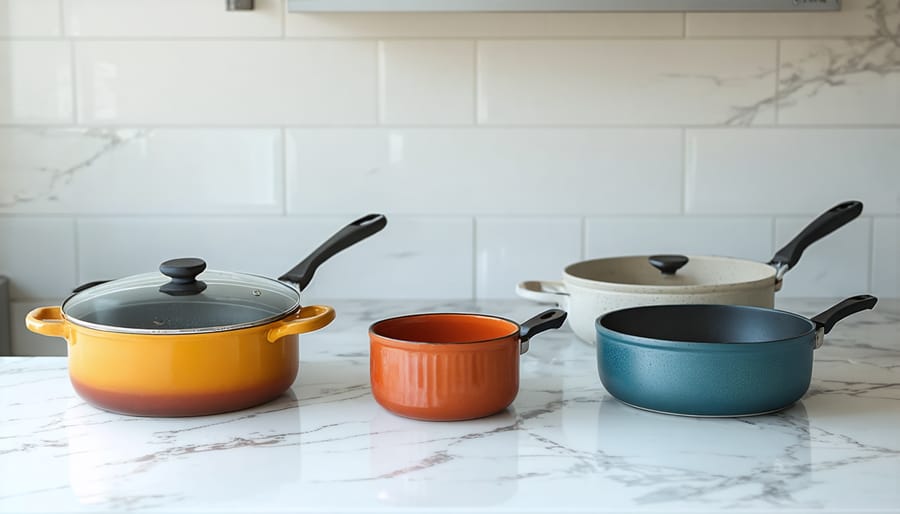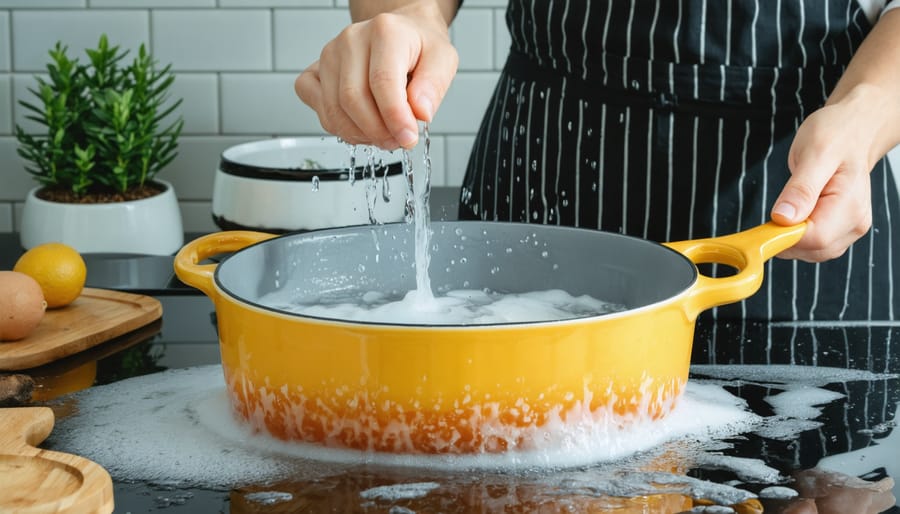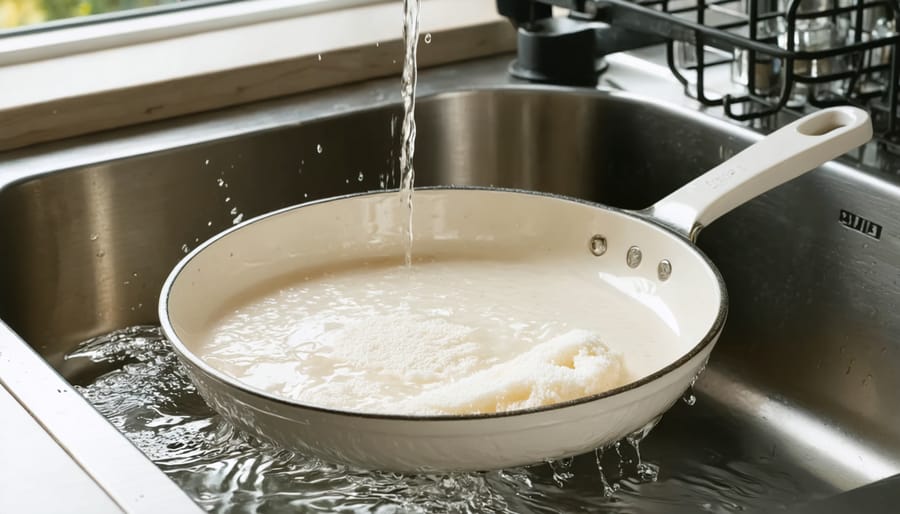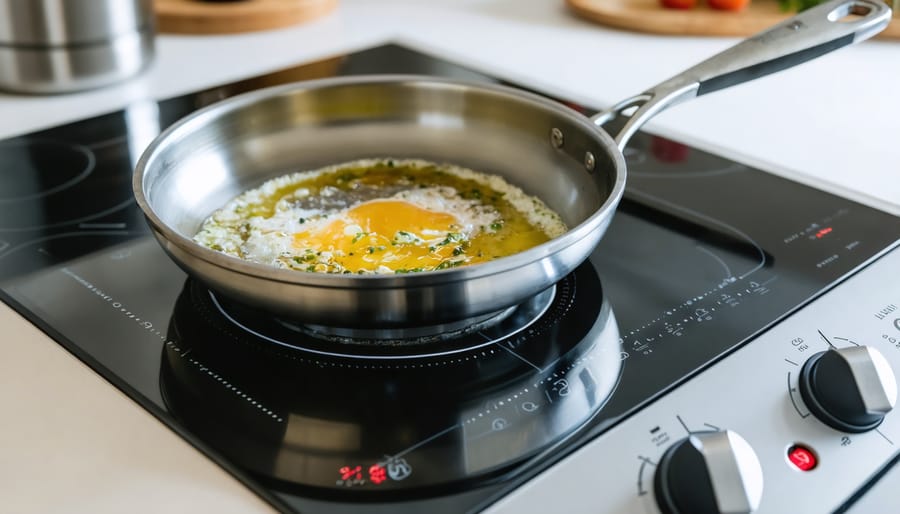Check the manufacturer’s label before loading your ceramic cookware into the dishwasher—most brands explicitly state whether their pieces can withstand automated cleaning cycles. While ceramic cookware offers a naturally non-stick surface that makes cleanup easier than traditional options, the dishwasher’s harsh detergents and high heat can gradually deteriorate the ceramic coating, leading to discoloration, reduced non-stick performance, and a shortened lifespan for your investment.
Hand-wash your ceramic pans with warm water and a soft sponge immediately after cooking, which takes less than two minutes and preserves the coating’s integrity for years. The ceramic surface releases food so easily that you rarely need more than a gentle wipe, making hand-washing far less tedious than you might expect. This simple habit protects your cookware the same way proper maintenance extends the life of other home investments—creating a sustainable approach to kitchen care that saves money long-term.
The short answer: most ceramic cookware technically survives the dishwasher, but consistent machine washing will compromise its performance over time. Understanding why this happens, recognizing the warning signs of coating damage, and learning the fastest hand-washing techniques helps you make informed decisions that align with both convenience and longevity. Whether you prioritize ease or durability determines your best approach, and knowing the trade-offs empowers you to care for your cookware in a way that fits your lifestyle while maintaining the warm, inviting kitchen space where you create meals and memories.
What Makes Ceramic Cookware Different from Traditional Pots and Pans

Pure Ceramic vs. Ceramic-Coated: Why It Matters for Cleaning
Understanding the difference between pure ceramic and ceramic-coated cookware is like knowing the difference between solid wood furniture and laminate—both serve a purpose, but they age very differently, especially when it comes to dishwasher exposure.
Pure ceramic cookware is made entirely from clay and minerals fired at high temperatures. Think of it as pottery you can cook with. This construction makes it naturally more resilient to dishwasher conditions because there’s no coating to worry about. The entire piece is ceramic through and through, so occasional dishwasher cycles are less likely to cause structural damage. However, even pure ceramic can develop hairline cracks over time from the harsh environment and temperature fluctuations inside your dishwasher.
Ceramic-coated cookware, on the other hand, features a metal base (usually aluminum or stainless steel) covered with a thin ceramic-based nonstick coating. This is where most dishwasher problems arise. The coating is only microns thick, and the combination of high heat, harsh detergents, and water pressure can gradually wear it away. You might notice the nonstick properties diminishing, discoloration appearing, or even peeling in extreme cases. When shopping for the best ceramic cookware options, it’s essential to know which type you’re considering.
For ceramic-coated pieces, hand washing is almost always the better choice to preserve that delicate surface layer and extend your cookware’s lifespan. Pure ceramic offers more flexibility, but gentle care still wins the day for longevity.
The Real Answer: Is Ceramic Cookware Dishwasher Safe?
Here’s the straightforward answer: most ceramic cookware technically can go in the dishwasher, but that doesn’t mean it should. Think of it like asking whether you can wash your favorite wool sweater in hot water—sure, you can, but you probably won’t love the results.
Many ceramic cookware manufacturers proudly stamp “dishwasher safe” on their packaging, and they’re not exactly lying. The ceramic coating itself can withstand the dishwasher’s environment. However, this simple label doesn’t tell the whole story about what happens over time or how your specific piece will hold up to repeated cycles.
The reality is more nuanced than a simple yes or no. Several important factors determine whether your ceramic cookware will thrive or deteriorate in the dishwasher. The quality of the ceramic coating matters significantly—premium brands often fare better than budget options. The age of your cookware plays a role too, since older pieces with existing wear are more vulnerable to damage. Even your dishwasher itself makes a difference, as harsh detergents, high temperatures, and aggressive spray patterns can gradually compromise the non-stick surface.
Just as you wouldn’t compromise on maintaining other valuable investments in your home, your ceramic cookware deserves thoughtful care. The question isn’t really whether you can use the dishwasher, but whether you should, given your priorities around convenience versus longevity. Understanding what actually happens inside that dishwasher—and weighing the trade-offs—will help you make the right choice for your lifestyle and kitchen needs. The decision ultimately comes down to balancing your time against the lifespan of your cookware investment.
What Actually Happens to Ceramic Cookware in the Dishwasher
The Heat Factor: How Dishwasher Temperatures Affect Ceramic Coatings
Think of your dishwasher like a high-powered heating system for your dishes. Most dishwashers reach temperatures between 130-170°F during their wash cycles, with some sanitizing cycles climbing even higher. While these temperatures work wonderfully for cleaning, they can be surprisingly harsh on ceramic cookware coatings over time.
The ceramic coating on your cookware is designed to withstand cooking heat, but the combination of prolonged hot water exposure, strong detergents, and repeated heating-cooling cycles creates a different kind of stress. Each dishwasher cycle subjects the coating to thermal expansion and contraction, gradually weakening the molecular bonds that give ceramic its prized non-stick surface. You might not notice it after one or two washes, but over months of regular dishwasher use, you’ll likely see the non-stick properties diminish.
This degradation happens because dishwasher heat doesn’t just clean—it creates microscopic changes in the coating’s structure. The surface may become slightly more porous, allowing food particles and oils to penetrate more easily. Eventually, what started as an effortlessly non-stick pan becomes one that requires more oil and elbow grease. Understanding this connection between heat and coating longevity helps you make informed choices about caring for your investment in quality cookware.
Harsh Detergents and Their Impact on Your Ceramic Surface
The detergents you use in your dishwasher can be surprisingly harsh on your ceramic cookware’s delicate finish. Many commercial dishwasher detergents contain powerful chemicals, including bleach, phosphates, and abrasive compounds designed to tackle tough, baked-on food residues. While these ingredients work wonders on stainless steel and glass, they can gradually wear down the ceramic coating that makes your cookware so wonderfully non-stick.
Think of it like the difference between gently cleaning your fireplace glass versus scrubbing it with industrial cleaners—sometimes gentler is better for longevity. Bleach-based detergents are particularly problematic because they can cause discoloration and create microscopic pitting on ceramic surfaces. Over time, this damage accumulates, causing your once-glossy cookware to appear dull and cloudy.
Abrasive particles in some detergents act like fine sandpaper during each wash cycle, slowly eroding the protective ceramic layer. This degradation doesn’t just affect appearance; it compromises the non-stick properties you rely on for healthy, low-fat cooking. If you must use your dishwasher, opt for milder, eco-friendly detergents without harsh chemicals or abrasives, and always check your manufacturer’s specific recommendations to protect your investment.
When You Can Safely Use Your Dishwasher (and When You Shouldn’t)
Reading Between the Lines: What ‘Dishwasher Safe’ Really Means
When manufacturers label ceramic cookware as dishwasher safe, they’re offering a technical truth with important asterisks attached. Think of it like how some oven-safe cookware has temperature limits—just because it can go in doesn’t mean it should always go in.
Most warranties covering dishwasher-safe ceramic cookware include qualifications that matter. They might specify using gentle cycles, positioning pieces on the top rack only, or avoiding certain detergent types. The fine print often reveals that while dishwasher exposure won’t immediately damage your cookware, repeated washing may gradually diminish the nonstick coating’s effectiveness over time.
Here’s what dishwasher safe typically means in practice: your ceramic pan won’t crack or warp in the dishwasher, but the manufacturer isn’t guaranteeing the coating will maintain its original performance indefinitely. Some brands explicitly state that hand washing extends product life, even when dishwasher use is technically permitted.
Before tossing your ceramic cookware in the dishwasher, check whether your warranty covers coating degradation from dishwasher use. Understanding these limitations helps you make choices that protect your investment while maintaining the cozy, efficient kitchen environment you’ve worked to create.
The Best Way to Clean Ceramic Cookware (That Actually Extends Its Life)

Quick Hand-Washing Techniques for Busy Kitchens
Let’s be honest—hand-washing dishes isn’t anyone’s favorite evening activity, especially after preparing a cozy family meal. But protecting your ceramic cookware investment doesn’t have to feel like a chore. Start by keeping a dedicated soft sponge near your sink specifically for your ceramic pieces, making cleanup feel less overwhelming.
The secret to speedy hand-washing is timing. Tackle those pans while they’re still warm (not hot!) by filling them with warm soapy water immediately after transferring your food. This five-minute soak prevents food from bonding to the surface, cutting your scrubbing time in half. Think of it as preventive maintenance, much like regularly cleaning your fireplace to keep it functioning beautifully.
Consider investing in a long-handled dish brush with soft bristles—it gives you better leverage and protects your hands from hot water while being gentle on ceramic coatings. A two-sink system works wonders too: one for washing, one for rinsing. This assembly-line approach makes hand-washing surprisingly efficient.
For particularly stubborn spots, a paste of baking soda and water works naturally without harsh chemicals, aligning with eco-conscious home care. The entire process typically takes just three to five minutes per pan—far less time than rewashing dishwasher-damaged cookware or replacing prematurely worn pieces. Making hand-washing part of your kitchen routine preserves both your cookware and your budget.
What to Do When Food Gets Stuck: Safe Cleaning Solutions
When food decides to cling stubbornly to your ceramic cookware, there’s no need to reach for harsh chemicals or aggressive scrubbers. Start with the gentle power of warm water and baking soda—create a paste by mixing three parts baking soda with one part water, then apply it to the stuck-on residue and let it sit for 15-20 minutes. This natural solution works beautifully without scratching your ceramic surface.
For particularly persistent spots, try filling the pan with warm water and adding a few tablespoons of white vinegar. Let it soak for 30 minutes, then use a soft sponge to wipe away the loosened food. This eco-friendly approach is kind to both your cookware and the environment, much like choosing sustainable solutions for other areas of your home.
If you’re dealing with oil buildup, a drop of mild dish soap combined with warm water and a non-abrasive cloth usually does the trick. Think of caring for your ceramic cookware as creating a nurturing environment in your kitchen—gentle, consistent attention prevents bigger problems down the road. These simple, natural methods keep your cookware looking beautiful while avoiding the need for harsh cleaning products that can compromise the ceramic coating over time.
Signs Your Ceramic Cookware Has Been Damaged by the Dishwasher
Knowing when your ceramic cookware has taken a hit from dishwasher use helps you make better decisions about care and replacement. Think of it like maintaining your home’s hearth—regular inspection keeps everything functioning beautifully.
The most obvious sign is a change in the cooking surface’s appearance. You might notice the once-smooth ceramic coating developing a dull, cloudy finish or chalky residue that won’t wipe away. This happens when harsh detergents strip away the protective layer, similar to how certain cleaners can damage other household surfaces. Some pieces develop tiny cracks or crazing patterns across the surface, which compromise the nonstick properties you originally loved.
Performance changes are equally telling. If food starts sticking where it never did before, or you find yourself using more oil than usual, the ceramic coating has likely degraded. You might also notice uneven heating, with hot spots appearing in areas where the coating has worn thin. Water may bead differently on the surface too—damaged ceramic often absorbs moisture rather than repelling it.
Color changes offer another clue. Many ceramic coatings fade, yellow, or develop brown stains that won’t scrub off, especially around the edges where detergent concentrates during wash cycles. These discolorations aren’t just cosmetic—they signal that the protective coating has broken down.
If you’re noticing any of these signs, it’s time to retire that piece or commit to gentler hand-washing for your remaining ceramic cookware. Protecting your kitchen investment means being as attentive to these tools as you are to creating a warm, functional home environment.

Caring for your ceramic cookware doesn’t have to be complicated, but it does require a bit of mindfulness. While the dishwasher might be convenient, taking a few extra minutes to hand-wash your pans can significantly extend their lifespan and keep them performing beautifully for years to come. Think of it as part of creating a sustainable, well-maintained home environment—just like properly caring for your fireplace ensures it provides warmth and ambiance season after season.
The small investment of time in proper cookware care pays dividends in both performance and longevity. When your ceramic pans maintain their nonstick properties, you’ll use less oil, create healthier meals, and avoid the waste of replacing cookware prematurely. These thoughtful kitchen habits align perfectly with eco-friendly living principles and contribute to a home that functions smoothly and sustainably.
Ultimately, the choice is yours, but understanding how your decisions affect your cookware empowers you to make informed choices. Whether you opt for gentle hand-washing or occasional dishwasher cycles, you’re taking steps toward a more intentional, caring approach to your home—one warm meal at a time.






